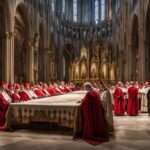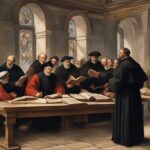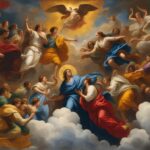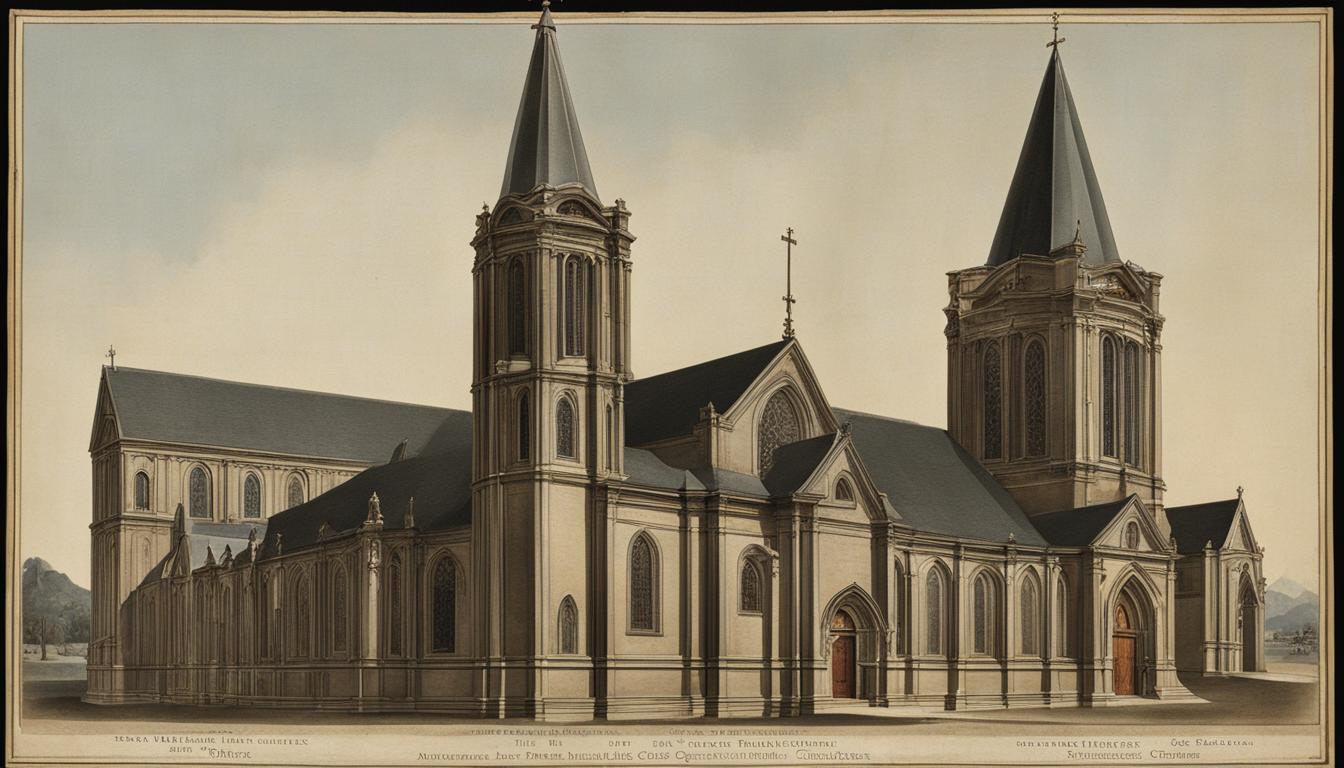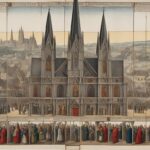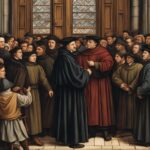The Counter-Reformation, also known as the Catholic Reformation, was a period of religious reform initiated by the Catholic Church in response to the Protestant Reformation. It was a time of significant changes and conflicts within the Catholic Church, particularly during the Council of Trent. This guide will provide a comprehensive overview of the Counter-Reformation and its impact on the Catholic Church.
- The Counter-Reformation was a response by the Catholic Church to the Protestant Reformation.
- The Council of Trent played a crucial role in outlining reforms and addressing issues within the Catholic Church.
- The Counter-Reformation led to significant changes in religious practices, organizational structure, and cultural expressions.
- Long-distance pilgrimages and preaching became important aspects of the Counter-Reformation.
- The influence of the Counter-Reformation extended to international relations and continues to shape the modern faith of the Catholic Church.
Varieties of Belief in Late Medieval Religion
The Counter-Reformation marked a significant shift in the religious landscape of the late medieval period. During this time, a wide range of beliefs and practices existed within the Catholic Church. Martin Jones, a renowned scholar, delves into the diverse array of religious perspectives during this era, shedding light on the internal reforms implemented by the Catholic Church from 1480 to 1542 in response to the Protestant Reformation.
In his exploration, Jones examines the efforts made by the Catholic Church to counter the influence of the Protestant movement. These efforts aimed to reaffirm and strengthen traditional Catholic beliefs and rituals. The Counter-Reformation sought to address the criticisms levied against the Church and restore faith in its teachings.
By studying the varieties of belief in late medieval religion, we gain a deeper understanding of the context in which the Counter-Reformation unfolded. This knowledge allows us to appreciate the complexities of this transformative period within the Catholic Church and the broader religious landscape of Europe.
Table: Varieties of Belief in Late Medieval Religion
| Belief System | Key Tenets |
|---|---|
| Mysticism | Direct personal experience of God’s presence |
| Devotional Practices | Intense focus on prayer, meditation, and acts of piety |
| Saint Veneration | Honoring the lives and intercession of saints |
| Superstitions | Belief in omens, magical remedies, and folk traditions |
| Hierarchical Authority | Submission to the teachings and authority of the Church |
This table provides an overview of the various belief systems that coexisted within the late medieval religious landscape. From mystical experiences and devotional practices to saint veneration and superstitions, these different beliefs influenced how individuals approached and understood their faith.
The Council of Trent
The Council of Trent was a crucial event during the Counter-Reformation, held between 1545 and 1563. It aimed to address the theological and organizational challenges posed by the Protestant Reformation and implement reforms within the Catholic Church. The Council of Trent had a profound impact on the Catholic Church, shaping its doctrines, practices, and structure.
During the Council of Trent, various significant decisions were made. For example, the Council reaffirmed the authority of the Pope and the Roman Catholic Church, asserting their role as the sole custodians of religious truth. It also clarified Catholic doctrines, including the nature of the Eucharist, the role of good works and faith, and the validity of the seven sacraments.
Furthermore, the Council of Trent addressed the issue of clerical abuses and sought to improve the education and discipline of the clergy. It emphasized the importance of seminaries and established strict guidelines for the selection and training of priests. These efforts aimed to restore the Church’s reputation and ensure the spiritual well-being of its members.
Overall, the Council of Trent was a watershed moment in the history of the Catholic Church. Its decisions not only countered the Protestant Reformation but also laid the foundations for the modern Catholic Church as we know it today.
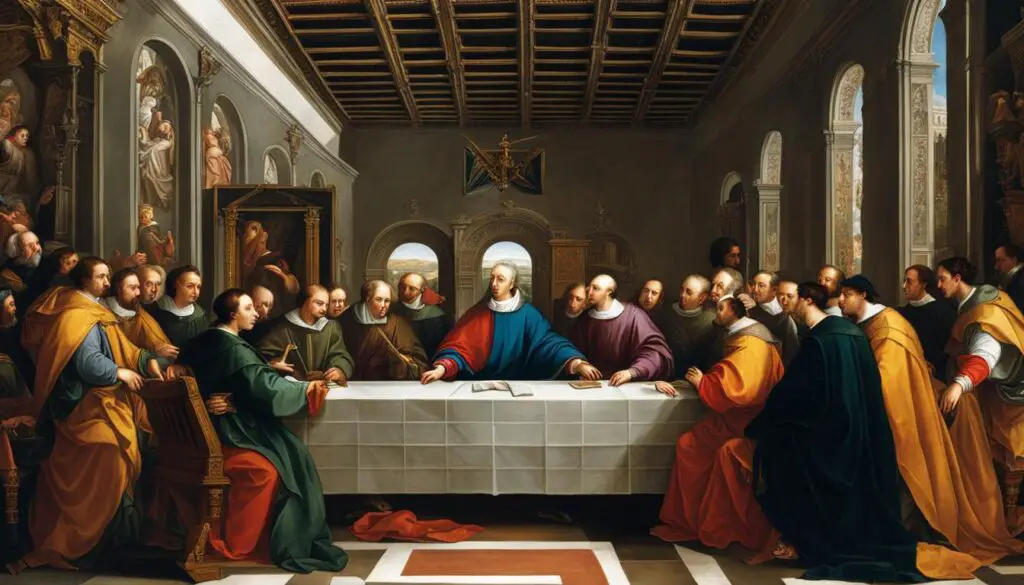
Structural Reforms in the Catholic Church
During the Counter-Reformation, the Catholic Church underwent significant structural reforms in response to the challenges posed by the Protestant Reformation. These reforms aimed to strengthen the Church’s authority, address widespread corruption, and reaffirm the Catholic faith. The Catholic Church implemented various changes to its organizational structure, hierarchy, and practices, ensuring a more cohesive and disciplined institution.
One of the key structural reforms was the establishment of new religious orders, such as the Society of Jesus (Jesuits), founded by Ignatius of Loyola. The Jesuits played a vital role in promoting Catholic doctrine and education, emphasizing intellectualism, missionary work, and spiritual discipline. Their strict hierarchical structure and loyalty to the pope ensured a unified front against Protestantism.
Another significant reform was the standardization of liturgy and the sacraments. The Council of Trent, a central event of the Counter-Reformation, addressed issues related to the liturgy and reaffirmed the importance of ritual and sacraments in Catholic worship. This led to the publication of the Roman Missal and the Catechism of the Council of Trent, providing a standardized framework for worship and religious instruction.
| Structural Reforms in the Catholic Church | Description |
|---|---|
| Establishment of new religious orders | Creation of orders like the Jesuits, focused on promoting Catholic doctrine and education. |
| Standardization of liturgy and sacraments | The Council of Trent provided a standardized framework for worship and religious instruction. |
| Reorganization of the Curia | The administrative body of the Catholic Church was restructured to enhance efficiency and centralize control. |
| Improvement of clerical education | Efforts were made to ensure that priests received proper education and training in theology. |
Additionally, the Counter-Reformation saw the reorganization of the Curia, the administrative body of the Catholic Church. The Curia was streamlined to enhance efficiency and centralize control, allowing for more effective governance and coordination within the Church.
Furthermore, the Counter-Reformation focused on improving clerical education. Seminaries were established to provide comprehensive theological education to priests, ensuring that they were well-prepared to serve the Catholic community and defend the faith against Protestant teachings.
The structural reforms undertaken by the Catholic Church during the Counter-Reformation were instrumental in revitalizing the institution and reinforcing its authority. These changes not only addressed the challenges posed by the Protestant Reformation but also laid the foundation for the modern Catholic Church as we know it today.
Reformation in the Parishes
The Counter-Reformation brought about significant changes in the way parishes functioned within the Catholic Church. The clergy and the laypeople both played crucial roles in the reform efforts during this period. The Catholic Church recognized the need to revitalize parish life and strengthen the relationship between the clergy and the people.
One of the key reforms introduced was the emphasis on proper training and education for the clergy. The Council of Trent mandated that priests undergo rigorous theological education to ensure their ability to guide and instruct parishioners effectively. This focus on education aimed to elevate the quality of pastoral care provided by the clergy.
Another crucial aspect of the Counter-Reformation was the increased attention given to the active participation of the laity in the life of the parish. The Catholic Church sought to foster a sense of community and engagement among the parishioners. This involved encouraging laypeople to take on leadership roles, participate in charitable works, and actively contribute to the spiritual and social life of the parish.
| Role of Clergy | Role of People | |
|---|---|---|
| Responsibilities | The clergy were responsible for providing pastoral care, administering sacraments, and guiding the spiritual life of the parishioners. | The people were encouraged to actively participate in the religious life of the parish through attending Mass, receiving sacraments, and engaging in acts of charity. |
| Education | Focus on theological education and training for the clergy to enhance their ability to guide and instruct the faithful. | Encouragement for the laity to deepen their religious education and understanding of Catholic teachings. |
| Leadership | The clergy held leadership positions within the parish, overseeing its functioning and religious activities. | Opportunities for laypeople to take on leadership roles within the parish, contributing to its governance and decision-making. |
| Community | Creating a sense of community and belonging among the parishioners, facilitating their spiritual growth and support. | Fostering a sense of active participation and engagement among the laity, encouraging them to contribute to the parish’s mission and social initiatives. |
These reforms transformed the parish into a more vibrant and engaged community, fostering a deeper sense of spiritual fulfillment and connection among the faithful. The Counter-Reformation sought to ensure that the parish became a vital center for religious life and a source of guidance and support for the Catholic faithful.
The Impact of Reform on Catholic Culture
The Counter-Reformation had a profound impact on Catholic culture, ushering in significant religious changes that reshaped the relationship between Catholicism and wider European society. These reforms influenced various aspects of Catholic culture, including religious practices, art, music, and literature.
One significant change brought about by the Counter-Reformation was the renewed emphasis on religious practices. The Catholic Church sought to reaffirm its doctrine and encourage devout piety among the faithful. As a result, practices such as the veneration of saints, pilgrimages, and the use of religious imagery gained prominence. This emphasis on religious practices aimed to deepen the spiritual connection between Catholics and their faith.
Alongside religious practices, the Counter-Reformation also had a substantial impact on the arts. The Catholic Church utilized art and architecture as powerful tools for conveying its doctrine and inspiring religious devotion. The period saw the rise of the Baroque style, characterized by elaborate ornamentation and dramatic effects. Artists such as Caravaggio, Bernini, and Rubens created grand religious paintings and sculptures that conveyed the emotional intensity and spiritual themes of the Catholic faith.
Furthermore, music played a vital role in Catholic culture during the Counter-Reformation. Composers such as Palestrina and Victoria crafted sacred music that reflected the intensified spirituality of the period. These compositions, characterized by their polyphonic textures and expressive melodies, were designed to elevate the religious experience and deepen the connection between the faithful and the divine.
The Impact of Reform on Literature
In addition to visual and auditory arts, the Counter-Reformation also influenced literature. Catholic writers sought to defend and promote their faith through literary works that conveyed religious themes and propagated Catholic teachings. One notable example is the “Spiritual Exercises” by St. Ignatius of Loyola, which outlined a series of meditations and contemplative practices aimed at fostering spiritual growth. The Counter-Reformation also saw the proliferation of devotional and instructional texts that guided Catholics in their religious journey.
Summary
The Counter-Reformation brought about significant changes in Catholic culture, impacting religious practices, art, music, and literature. The emphasis on religious practices deepened the connection between Catholics and their faith, promoting devotion and piety. The arts became powerful tools for conveying Catholic doctrine and inspiring religious devotion, with artists creating grand religious works in the Baroque style. Music, too, played a central role, with composers crafting sacred compositions that heightened the spiritual experience. The Counter-Reformation also influenced literature, with Catholic writers producing works that defended and propagated the Catholic faith. Overall, the reforms of the Counter-Reformation had a lasting impact on Catholic culture, shaping the way Catholics expressed and experienced their religious beliefs.
The Role of Preaching in the Counter-Reformation
The Counter-Reformation placed a renewed emphasis on preaching as a means of spreading Catholic doctrine and inspiring the faithful. Preaching became a powerful tool in the Catholic Church’s efforts to counter the influence of the Protestant Reformation. During this period, sacred oratory played a vital role in shaping the Catholic worldview and strengthening the Church’s authority.
Preaching in the Counter-Reformation went beyond simple sermons. It became a carefully crafted art form, employing rhetorical techniques to stir emotions and sway the hearts and minds of the congregation. Preachers skillfully used gestures, intonations, and dramatic devices to captivate their audience, creating a sense of awe and reverence.
The importance of preaching during the Counter-Reformation is evident in the works of renowned preachers such as Roberto Bellarmino and Bernardino Ochino. Through their sermons, they conveyed the teachings of the Catholic Church, defended its doctrines, and refuted Protestant ideas. These influential preachers became influential figures in the Catholic Reformation, inspiring countless individuals to remain faithful to the Church.
“Preaching is a divine gift, a powerful means to renew the faithful and strengthen their commitment to Christ.”
The impact of preaching during the Counter-Reformation extended beyond the walls of the church. Through printed sermons, religious tracts, and pamphlets, the message of the Catholic Church reached a wider audience. It not only reaffirmed the faith of Catholics but also sought to convert those who had fallen under the sway of Protestantism. Preaching became a means of reclaiming lost souls and reinforcing Catholic unity.
The role of preaching in the Counter-Reformation cannot be overstated. It served as a cornerstone of the Catholic Church’s response to the challenges posed by the Protestant Reformation. Through skilled orators and powerful sermons, the Catholic Church sought to revitalize its authority, reclaim its followers, and reaffirm its position as the one true Church.
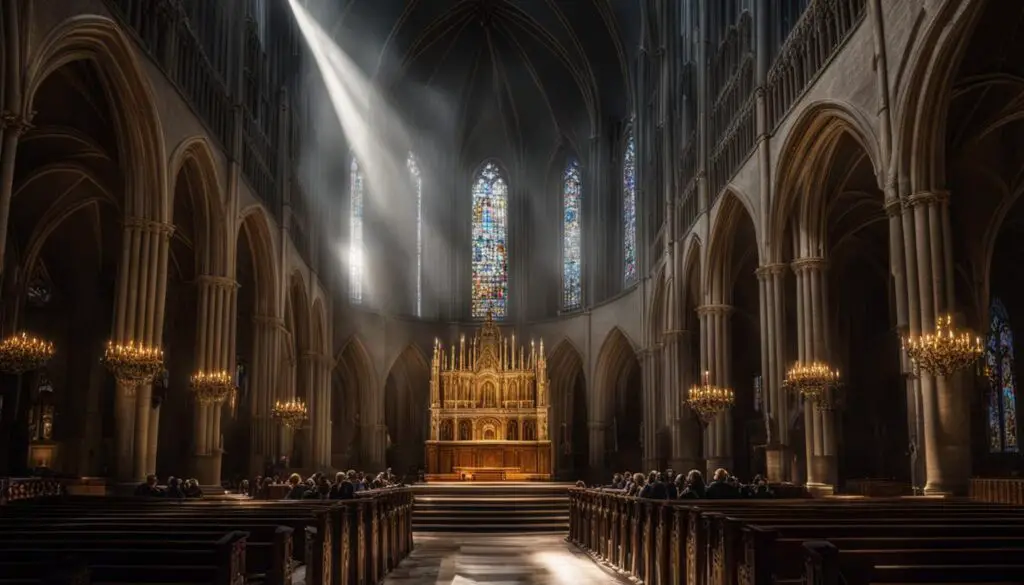
Long-Distance Pilgrimage and the Counter Reformation
In the Counter-Reformation, long-distance pilgrimage became a popular form of religious devotion. One of the notable destinations for these pilgrimages was Mont Saint-Michel in France. Pilgrims would travel for miles to reach this sacred site, seeking spiritual solace and blessings.
The practice of long-distance pilgrimage during the Counter-Reformation was deeply rooted in the concept of devotion. It was believed that undertaking arduous journeys to holy places would help purify the soul and deepen one’s connection with God. Pilgrims would often embark on these pilgrimages as acts of penance, seeking forgiveness for their sins or expressing gratitude for answered prayers.
“The pilgrimage to Mont Saint-Michel was a transformative experience for many Catholics during the Counter-Reformation. It provided an opportunity for people to step away from their daily lives and immerse themselves in a sacred space. The awe-inspiring architecture, the solemn rituals, and the collective prayers offered a sense of spiritual renewal and unity,”
The revival of long-distance pilgrimages during the Counter-Reformation was significant in fostering religious fervor and inspiring a sense of community among Catholics. It allowed individuals from different backgrounds to come together in their shared faith, creating bonds of solidarity and reinforcing their commitment to the Catholic Church.
The Significance of Mont Saint-Michel
Mont Saint-Michel, situated on a rocky island off the coast of Normandy, was a symbol of spiritual fortitude and a testament to the enduring power of Catholicism. Its breathtaking abbey and the grandeur of its architecture attracted pilgrims from far and wide. The journey to Mont Saint-Michel was often arduous, involving treacherous terrain and long hours of travel, but the destination itself offered a sense of peace and sanctuary.
At Mont Saint-Michel, pilgrims would participate in religious ceremonies, attend mass, and seek blessings from the resident monks. The pilgrimage experience was enriched by the physical challenge, the camaraderie of fellow pilgrims, and the opportunity to reflect on one’s faith. It was a transformative journey that allowed individuals to reconnect with their spirituality and find solace in the presence of God.
“The pilgrimage to Mont Saint-Michel was not just about reaching a physical destination. It was a journey of the soul, a quest for divine grace and enlightenment. The pilgrimage experience itself was deeply meaningful, offering pilgrims the opportunity for introspection, reconciliation, and spiritual growth,”
| Benefit of Long-Distance Pilgrimage in the Counter-Reformation | Explanation |
|---|---|
| Deepening of Spiritual Connection | The challenging journey and the sacred destination allowed pilgrims to connect with their faith on a deeper level, fostering a stronger bond with God. |
| Community Building | Pilgrims from different backgrounds and regions came together during the pilgrimage, creating a sense of unity and reinforcing the collective identity of Catholicism. |
| Renewal and Rejuvenation | The pilgrimage provided a break from the routine of daily life and offered a space for reflection, renewal, and rejuvenation of the spirit. |
| Experience of Divine Grace | Pilgrims sought blessings and divine intervention at their destination, believing that the journey itself made them more receptive to experiencing God’s grace. |
The revival of long-distance pilgrimage during the Counter-Reformation left a lasting impact on Catholic culture and spirituality. It served as a powerful means of religious expression and a testament to the enduring faith of the Catholic Church.

Influence of the Counter-Reformation on International Relations
The Counter-Reformation had a significant impact on international relations during the period. It played a role in shaping religious conflicts and the responses of Catholic countries to Protestantism. The Catholic Church, through its various initiatives and reforms, sought to combat the spread of Protestant ideas and maintain its influence and power.
One of the key aspects of the Counter-Reformation was the establishment of the Jesuit order. The Society of Jesus, as they were known, played a crucial role in spreading Catholicism and countering Protestantism. They engaged in missionary activities, established schools and universities, and served as advisors to Catholic rulers. Their efforts contributed to the strengthening of Catholic influence both within Catholic countries and in regions where Protestantism was gaining ground.
Religious conflicts between Catholic and Protestant nations became a defining feature of international relations during the Counter-Reformation. The wars and conflicts that ensued, such as the Thirty Years’ War, were often fueled by religious tensions and rivalries. Catholic countries, led by Spain, fought against Protestant nations, most notably England and the Dutch Republic. These conflicts had lasting geopolitical consequences and reshaped the balance of power in Europe.
The Response of Catholic Countries
Catholic countries, alarmed by the spread of Protestantism, responded by implementing policies aimed at preserving Catholicism and stamping out heresy. In Spain, for example, the Spanish Inquisition was established to identify and punish those suspected of Protestant beliefs. Similarly, in France, the Catholic monarchy sought to suppress Protestantism through the Edict of Fontainebleau.
These responses to the Protestant Reformation had far-reaching implications for international relations. They not only deepened the divide between Catholic and Protestant nations but also fostered alliances and conflicts based on religious identity. The Counter-Reformation, therefore, had a profound impact on the political landscape of Europe and set the stage for future tensions and conflicts that would shape the continent for centuries to come.
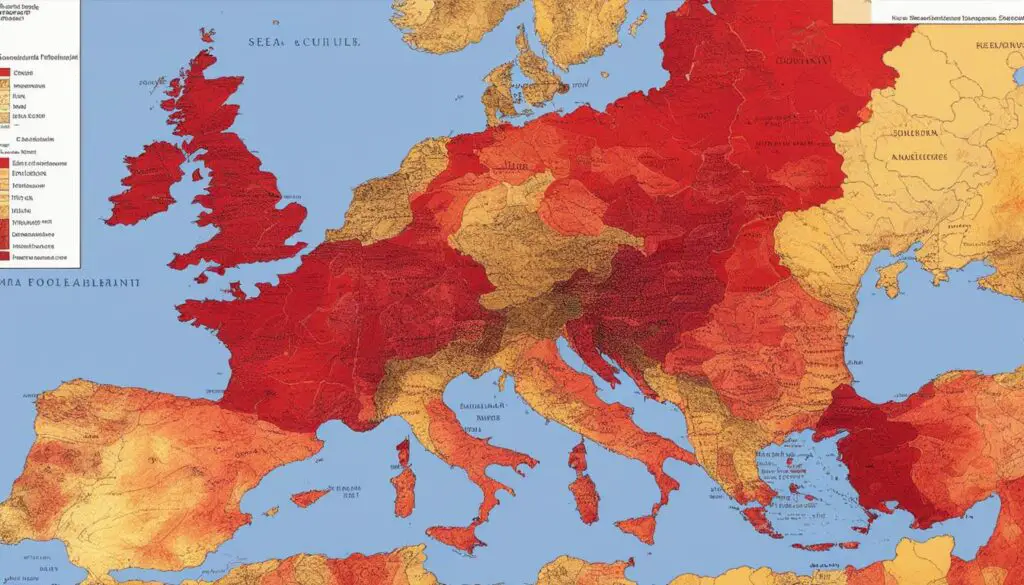
Counter-Reformation and the Modern Faith
The Counter-Reformation, also referred to as the Catholic Reformation, continues to shape the contemporary faith and practices of the Catholic Church. The reforms implemented during this period have had a lasting impact on the Church’s relationship with other Christian denominations and its approach to religious changes. By understanding the Counter-Reformation, we can gain valuable insights into the evolution of Catholicism and its enduring influence on religious history.
Throughout the Counter-Reformation, the Catholic Church implemented structural reforms aimed at addressing the issues raised by the Protestant Reformation and strengthening its authority. These changes have had long-lasting effects on the Church’s organizational structure, hierarchy, and decision-making processes. Today, the Catholic Church’s hierarchical structure and centralized authority can be traced back to the reforms undertaken during this period.
Furthermore, the Counter-Reformation brought about significant changes in religious practices within the Catholic Church. The emphasis on liturgical renewal, devotion to the Eucharist, and the use of art and music as tools of spiritual expression all have their roots in the reforms of the Counter-Reformation. These changes continue to shape Catholic worship and spirituality in the modern era.
In terms of interfaith relations, the Counter-Reformation also played a crucial role in defining the Catholic Church’s approach to ecumenism and dialogue with other Christian traditions. The Church’s response to the Protestant Reformation during the Counter-Reformation set the stage for centuries of theological discussions, ecumenical movements, and efforts towards unity among Christian denominations. The ongoing dialogue between the Catholic Church and other Christian traditions today is influenced by the historical context and reforms of the Counter-Reformation.
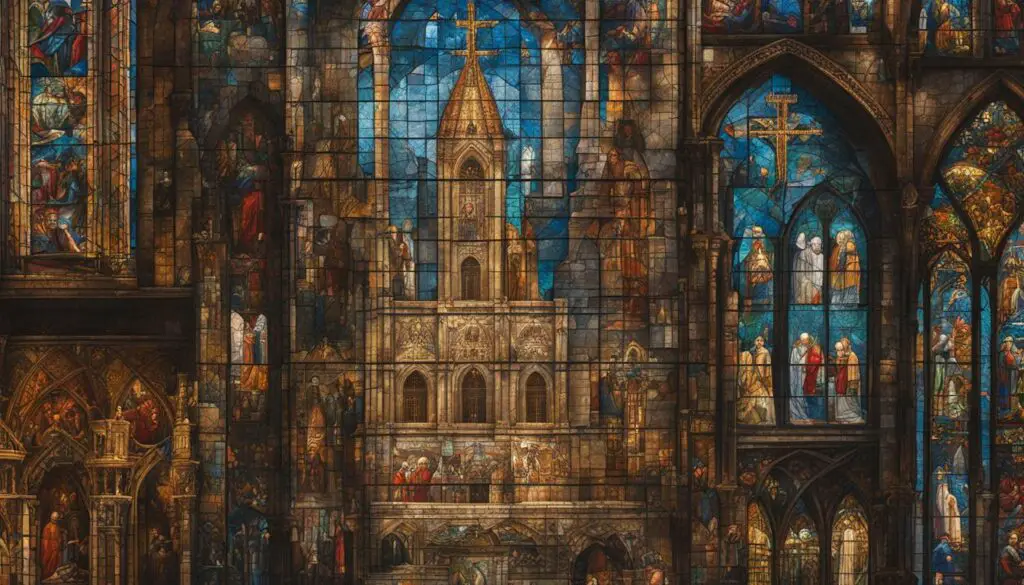
Table: Key Reforms of the Counter-Reformation
| Reform | Description |
|---|---|
| Structural Reforms | Changes to the organizational structure and hierarchy of the Catholic Church, strengthening its central authority. |
| Liturgical Renewal | Emphasis on the revitalization of Catholic worship and the celebration of the sacraments. |
| Devotion to the Eucharist | Promotion of the belief in the real presence of Christ in the Eucharist and increased emphasis on its adoration. |
| Promotion of Sacred Art | Use of visual arts, such as paintings and sculptures, to communicate religious messages and inspire devotion. |
| Literary and Musical Reforms | Encouragement of the production of religious texts, music, and hymns that reinforced Catholic teachings and spirituality. |
By examining the Counter-Reformation and its impact on the modern faith, we can gain a deeper understanding of the Catholic Church and its continued relevance in the contemporary world. The reforms implemented during this period continue to shape the Church’s structure, worship practices, and engagement with other Christian traditions, making the Counter-Reformation a pivotal period in the history of Catholicism.
Conclusion
The Counter-Reformation was a pivotal period in the history of the Catholic Church. It brought about significant changes in religious practices, organizational structure, and cultural expressions. The reforms implemented during this period continue to shape the faith and traditions of the Catholic Church. Understanding the Counter-Reformation provides valuable insights into the evolution of Catholicism and its enduring impact on religious history.
The Counter-Reformation was a response to the challenges posed by the Protestant Reformation and aimed to strengthen the Catholic Church from within. Through the Council of Trent, the Catholic Church addressed various issues, including doctrinal disputes, clerical reform, and the role of the laity. These decisions not only solidified the Church’s teachings but also revitalized its organizational structure.
Furthermore, the Counter-Reformation had a profound influence on Catholic culture. It sparked a resurgence in religious practices, resulting in the creation of breathtaking artworks, inspiring music, and powerful literature. The Counter-Reformation also promoted the importance of preaching and the experience of pilgrimage, further engaging the faithful and strengthening their connection to the Church.
The impact of the Counter-Reformation reached beyond religious contexts and had significant implications for international relations. The conflicts and tensions between Catholic and Protestant states during this period shaped diplomatic and military strategies, leaving lasting marks on the geopolitical landscape.
FAQ
What is the Counter-Reformation?
The Counter-Reformation, also known as the Catholic Reformation, was a period of religious reform initiated by the Catholic Church in response to the Protestant Reformation.
When did the Counter-Reformation take place?
The Counter-Reformation occurred during the 16th and 17th centuries.
What was the Council of Trent?
The Council of Trent was an ecumenical council held between 1545 and 1563 that addressed various issues raised by the Protestant Reformation and outlined reforms within the Catholic Church.
What were the structural reforms implemented during the Counter-Reformation?
The Catholic Church implemented significant structural reforms during the Counter-Reformation to address the issues raised by the Protestant Reformation and strengthen its authority.
How did the Counter-Reformation impact the parishes?
The Counter-Reformation brought about changes in the parishes, involving both the clergy and the laypeople.
How did the Counter-Reformation influence Catholic culture?
The Counter-Reformation had a profound impact on Catholic culture, resulting in changes in religious practices, art, music, and literature.
What was the role of preaching in the Counter-Reformation?
Preaching played a crucial role in the Counter-Reformation, serving as a means of spreading Catholic doctrine and inspiring the faithful.
What was the significance of long-distance pilgrimage during the Counter-Reformation?
Long-distance pilgrimage experienced a revival during the Counter-Reformation and served as a form of religious devotion for Catholics.
How did the Counter-Reformation impact international relations?
The Counter-Reformation played a role in shaping religious conflicts and the responses of Catholic countries to Protestantism, influencing their diplomatic and military strategies.
How does the Counter-Reformation continue to shape the modern Catholic Church?
The reforms implemented during the Counter-Reformation continue to influence the faith and practices of the Catholic Church in the present day.

